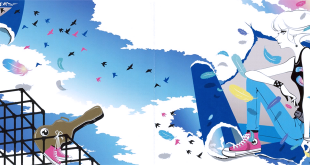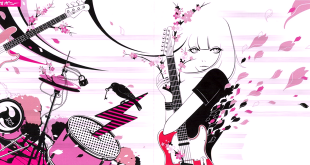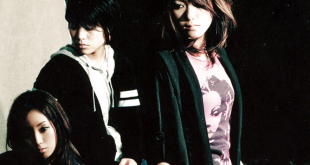We interrupt Kaizoku Sentai Gokaiger meets Kaoru-hime to bring you this article on the second half of Hydrangea ga Saiteru…
Welcome back to our two-part series on Hydrangea ga Saiteru This one will be a little longer since most of the new songs are on this end of the album.
 Why no one decided to use “Effective Line” as an anime opening or even as an insert song or something is beyond me. It is the perfect length, under a minute and a half, and you do not need to take a full length song and cut it down to an intro, first verse, chorus, and then second or repeat chorus. With that aside, it only stays out of my playlist because it is so short. It comes on strong, then rushes at full speed only to end abruptly, leaving you hanging almost with an empty feeling of “That’s it?” As with most Stereopony songs, Shiho’s drums keep the tempo as they should, and the guitar and vocals from Aimi power this one through. I would love this song a bit more, I think, if it weren’t for its short length.
Why no one decided to use “Effective Line” as an anime opening or even as an insert song or something is beyond me. It is the perfect length, under a minute and a half, and you do not need to take a full length song and cut it down to an intro, first verse, chorus, and then second or repeat chorus. With that aside, it only stays out of my playlist because it is so short. It comes on strong, then rushes at full speed only to end abruptly, leaving you hanging almost with an empty feeling of “That’s it?” As with most Stereopony songs, Shiho’s drums keep the tempo as they should, and the guitar and vocals from Aimi power this one through. I would love this song a bit more, I think, if it weren’t for its short length.
Fortunately, “Sweet Blue” is. Maybe it is the guitar riffs that lead into the verses that earned it a place on my Zen player. Or maybe how it calms down with soft strumming and the occasional drum beats from Shiho. The optimism that one is full of during the “four-year vacation from life”, what one of my teachers called undergraduate studies (I will refrain from using the words “college” and “university” because although they are used interchangeably by Americans like myself, they refer to two very different levels of education in other parts of the world, and not wanting my meaning to be lost quicker than Lady Tsunade in a poker tournament, I will make myself extremely clear. We now return you to your regularly scheduled article.) where nothing bad can happen, and that diploma is a one-way ticket to your first professional job, with that “If I work hard, everything will turn out okay!” feeling, only to finally get there and realize that there is more to it than just having a positive attitude. The girl in the song could easily move back to the small town where she grew up after being disillusioned by the big city, but in my case, it is a vacation I wish I could take again but sadly cannot. The chorus of “Sweet Blue Days” only makes you feel blue (as in the feeling, not the color), and that feeling is revisited with a more happy outlook in a song we will discuss later.
I will agree with Ms. Salad on this one; after getting us all energized, the roller coaster makes its slow turn back into the station. “Tokai no Mori” sounds good with the guitar work, but it feels like an ending theme for an anime. Which leads me another point, why did they stick “Hitohira no Hanabira” at the END of Bleach when it probably had the energy to lead off? “Shiawase no Oka de Kurashita” is a ballad, and although I like ballads, I can only take so many per CD. “Tokai” talks about the loneliness of being in the big city, which maybe echoes back to the previous song, adding in a feeling of not giving up. “Shiawase” tells us to hold onto our childhood dreams, but to me, that “hill of happiness” is that place we all want to go to when we do not want to face the world. Perhaps my colleague is correct in thinking that the songs were misplaced, but Aimi’s voice always lends itself to ballads, and apart from their placement in the album, they are still good songs; it’s just that I think the songs seem a little bit out-of-place. Anyway, let’s move on.
“My Mistake” is a point towards “bad album placement”. The song is well put-together and has great energy. It talks about someone sitting on the train platform, contemplating whether or not they should board the train to go see their significant other with the intent of breaking up, all the while ignoring calls from said person as they sit there. This is clear from the repeated uses of “I’m running away from you/I’m afraid of you”. It sounds like a textbook abusive relationship. The singer does not want to board the train to go see their lover and tell them in person “it’s over”, for fear of what might happen, and ignores the repeated calls from this person (which might have been the reason WHY she wants to break up with him), again, because telling them over the phone might make them even madder and restraining orders will need to be filed. The only way to get out of this relationship relatively intact is to just go cold turkey: ignore their calls, block their number, avoid seeing them, just get back on the train to take you home (I’m going out on a limb here to assume that the train station is at the halfway point between the two and the singer needs to switch trains here to either go to them or to go home). Aimi seriously has some explaining to do about her lyrics; with every passing song that I GET, I become more convinced that her songs are only a tiny percent extrapolation, and primarily from either her own experiences, that of her band mates, or one of their friends.
 After songs about loneliness and bad relationships, the album ends on a happy note, with “Aozora Very Good Days!” During excursions to write in the park, I always make sure to play this song at least once, in hopes that it will bring good weather. Everything seems to fit together in this one song so well; the enthusiasm of the lyrics to keep running towards your goals; the energy of the guitars at some points and how Aimi softens things with the lyrics are great, and to start up full speed again for the chorus is exhilarating. This is definitely on my all-time-favorites list, for the happy memories of seeing the girls twice, and being that it is also our theme song (the site’s namesake, if you will), I think of my time and contributions with the site as well. Again, someone who compiled set lists will need to remind me if I had the opportunity to hear this at one of their lives, because I do not recall hearing it at either Anime Boston or Sakura-con. I will have to check my booklet from Anime Boston because I did write down a bunch of the songs from the set that I recall. We really need to start appointing someone from Very Good Days! to keep track of the songs played at Aimi’s or Draft King’s sets and log back Stereopony’s set so that all I have to do is check and say with confidence, “Yes Des, you did hear that at one of the two shows you went to.”
After songs about loneliness and bad relationships, the album ends on a happy note, with “Aozora Very Good Days!” During excursions to write in the park, I always make sure to play this song at least once, in hopes that it will bring good weather. Everything seems to fit together in this one song so well; the enthusiasm of the lyrics to keep running towards your goals; the energy of the guitars at some points and how Aimi softens things with the lyrics are great, and to start up full speed again for the chorus is exhilarating. This is definitely on my all-time-favorites list, for the happy memories of seeing the girls twice, and being that it is also our theme song (the site’s namesake, if you will), I think of my time and contributions with the site as well. Again, someone who compiled set lists will need to remind me if I had the opportunity to hear this at one of their lives, because I do not recall hearing it at either Anime Boston or Sakura-con. I will have to check my booklet from Anime Boston because I did write down a bunch of the songs from the set that I recall. We really need to start appointing someone from Very Good Days! to keep track of the songs played at Aimi’s or Draft King’s sets and log back Stereopony’s set so that all I have to do is check and say with confidence, “Yes Des, you did hear that at one of the two shows you went to.”
There, you have it. “Hydrangea ga Saiteru” has its up and downs, and I agree with Ms. Salad; two things that could have made this better were the placement of songs to let the album flow better and not try to dilute Aimi’s voice with the music. I have said in the past that I heard Nohana and Shiho more when I saw them live than I ever heard them on their CD’s, but there is an energy and a passion behind Aimi that equates to what Nohana said about her in one of their interviews: “[Aimi] is tiny in height, but she is very powerful in everything else.” You could say she holds back a bit on the CD’s so she can put everything into their lives, but even I was surprised when I first heard Aimi live. It is as if there is a “Studio Aimi” and a “Live Aimi”. Nonetheless, I enjoyed this album. As the first CD of theirs I ever bought, it does hold a special place in my heart and collection. One of my biggest regrets is failing to get the liner notes autographed not once, but twice…
Review Overview
effective line - 90%
Sweet Blue - 93%
Tokai no Mori - 80%
Shiawase no Oka de Kurashitai - 80%
My Mistake - 96%
Aozora Very good days!! - 100%
90%
Very Good!
The second half of the album does well to complement the first half, but bad song placement makes it a roller coaster ride. If the two ballads were put right before Very Good Days, with My Mistake following Sweet Blue, it would have been a much better layout. But my goal is to review and rate the music, not how the album was set up, so in that respect, Stereopony did a great job.
Break Down
Break Down
Effective Line – 90%
Music – 100/100
Lyrics – 80-/100
Vocals – 90/100
Overall execution – 90/100
Sweet Blue – 93%
Music – 100/100
Lyrics – 80/100
Vocals – 100/100
Overall execution – 93/100
Tokai no Mori – 80%
Music – 70/100
Lyrics – 90/100
Vocals – 80/100
Overall execution – 80/100
Shiawase no Oka de Kurashitai – 80%
Music – 80/100
Lyrics – 80/100
Vocals – 80/100
Overall execution – 80/100
MY MISTAKE – 96%
Music – 90/100
Lyrics – 100/100
Vocals – 100/100
Overall execution – 96/100
Aozora Very Good Days! – 100%
Music – 100/100
Lyrics -100/100
Vocals – 100/100
Overall execution – 100/100
 Very Good Days Home of the AIMI, Draft King, and Stereopony Community
Very Good Days Home of the AIMI, Draft King, and Stereopony Community









